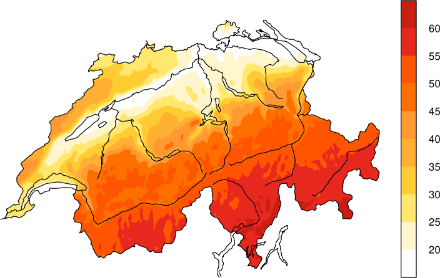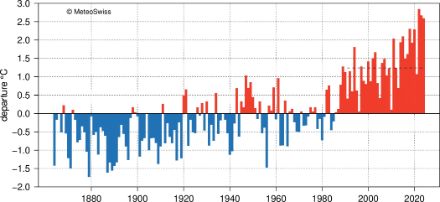Service Navigation
Search
In central Switzerland, winter months such as January are often characterised by hazy and fairly cool weather conditions with north-easterly winds and low stratus cloud. Yet the same month in the following year may equally be mild and sunny, because the weather fluctuations in Switzerland are relatively large from year to year. So, what does a typical January look like in central Switzerland, and how much rain is to be expected in Ticino in springtime? The answers to these questions are provided by long-term averages of meteorological data series. These data are not only interesting from a scientific standpoint, but they also serve as a basis for planning decisions by government authorities as well as various industrial sectors such as agriculture, energy, construction and tourism.

International comparability
In line with the World Meteorological Organisation (WMO) specification that was introduced in 1935, the same 30-year periods are used around the world to determine climatological averages. In order to enable comparisons across national boundaries of climate and climatological reports from the different meteorological services, it is important to have international coordination and standardisation. The averages of these standard 30-year periods are referred to as normals or climate normals.
Normals in a changing climate
In light of long-term climate changes, the normal periods are regularly updated in order to ensure that the normals properly reflect the current climate of a particular region. Whereas the normal period used only to be updated every 30 years, the significant climatological changes of the past decades have led the WMO to recommend that the normal period be updated more regularly - i.e. every 10 years (1981-2010, 1991-2020, etc.). MeteoSwiss has been implementing this recommendation since 1 January 2013, and always uses the most recent complete period for its reports and products. In accordance with WMO recommendations, the period from 1961 to 1990 is used as the fixed reference period for monitoring long-term climate change.

Adjustments to account for changes in measuring conditions
Normals are often used to compare the actual weather conditions occurring in a region with the average expected climate. Such a comparison is made for Switzerland and published in the MeteoSwiss Climate Bulletin, which reports on whether a period has been comparatively wet, warm or sunny. For these comparisons to be valid, the normal values must be comparable to the current measured values. If the measuring conditions of a station have changed, for example due to the relocation of the station, then the normals have to be adjusted to account for this change. The corresponding process for this adjustment is referred to as Homogenisation. The MeteoSwiss meteorological service makes such adjustments every year on 1 January, as necessary.
Provision of normals data and maps
The MeteoSwiss meteorological service provides annual and monthly data and maps for the current normal period for various parameters and stations: